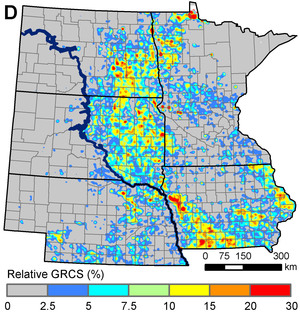As farmers race to plant crops for biofuels they are destroying what’s left of America’s native prairies.
In fact, our grasslands are disappearing at rates comparable to deforestation in Brazil, Malaysia and Indonesia, concludes a study conducted at South Dakota State University.
Between 2006-2011, an astounding 1.3 million acres of US prairies were converted into corn and soybean fields to meet aggressive biofuel mandates. Those mandates have also driven up prices for those crops, making it even more attractive for farmers to plant them everywhere they can.
The rate was fastest in South Dakota and Iowa, with as much as 5 per cent of pasture becoming cropland each year.
Iowa and South Dakota are losing the most prairie – 5% a year. This chart shows the percentage of acreage converted from 2006-2011.

That’s the biggest loss of prairie since the 1930s – the days of the devastating Dust Bowl – and the practice could have serious economic and environmental impacts, says the study.
Removing prairies in drought-prone areas like Nebraska, North Dakota and South Dakota, for example, and planting them with corn or soy, leaves the price tag with US taxpayers to cover any losses with federal crop insurance.
Of course, losing our prairie means disappearing wildlife habitats. Half of the ducks in North America breed in the Prairie Pothole Region across Minnesota and the Dakotas – and ground-nesting bird populations that need tall grasses for food and protection from predators, are crashing as cornfields encroach.
Grasslands also absorb carbon much better than croplands. Destroying them to grow fuel crops like corn ethanol or soy-based biodiesel erases any benefits of replacing petroleum-based fuels with biofuel.
A recent report (pdf) from the Environmental Working Group, for instance, argues that Congress should scale back crop insurance for farmers who move into the country’s grasslands and wetlands.
This is just the latest evidence questioning the value of biofuels.

I don’t doubt there is a land grab going on but, where is the proof that biofuels are the cause? Anyone doing a University study should know better than to make such a leap.
Commodities are up due to more demand in Asia. Is the high price of copper due to biofuels too? Farm land prices are up due to high commodity prices AND a lack of good investments for all the money still wary of other real estate and the stock market.
The mash left over after biofuel production still goes to animal feed (where most corn goes anyway) The food vs. fuel debate lacks any scientific rigor. A debate closer to reality would be called Soda Pop (high fructose corn syrup) vs. fuel.
“to grow fuel crops like corn ethanol or soy-based biodiesel erases any benefits of replacing petroleum-based fuels with biofuel.” Again, where is the evidence behind this pantload?
The strength of this study is the measurement of land use change. However, the link to biofuels and the judgment on the value of biofuels policy is not supported by the data in this research and does not merit the headlines afforded by story. A more accurate interpretation of the recent land use change is that farmers are once again finding it economical to grow food on cropland that was previously abandoned due to low commodity prices. Farmers are not tilling up virgin grasslands, but are instead putting land back to work that is being expelled from the Conservation Reserve Program due to Farm Bill budget cuts. Find more facts at http://www.biodieselsustainability.com/2013/02/21/biodiesel-has-a-critical-role-in-preserving-farmland-and-preventing-detrimental-land-use-change/
Corn ethanol is old technology. Giant miscanthus has a much higher fuel conversion per acre and it as a perenial grass it is much better for the environment than corn. It should replace the corn not needed for food as the feedstock for new drop in gasoline and butanol. Why not?